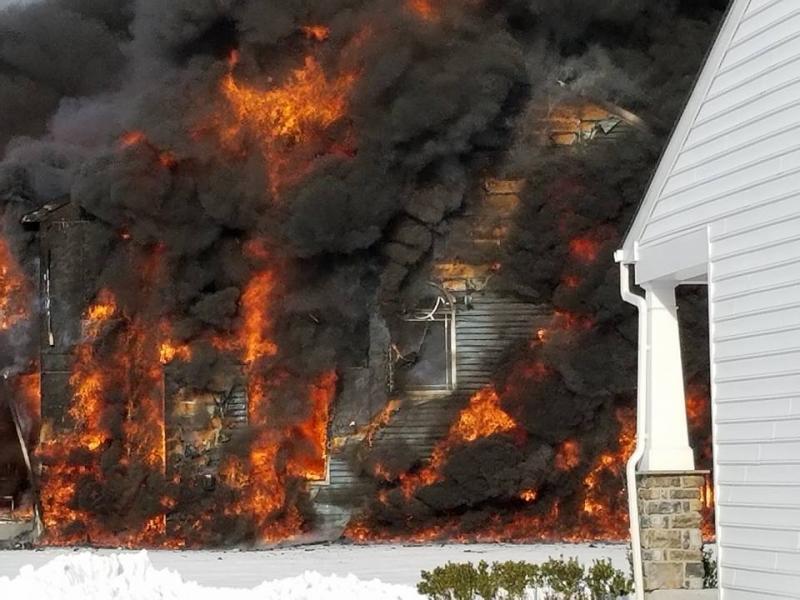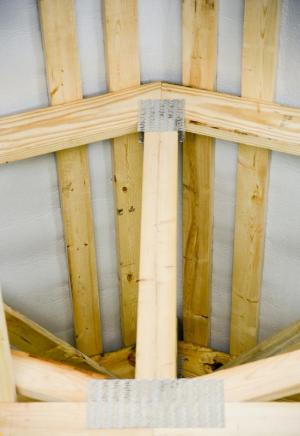The blaze that destroyed a new home near Red Mill Pond in early January was so intense, fire officials say, the best firefighters could do was protect surrounding properties as the house burned to the ground.
“The house is totally destroyed. It's on the ground,” said Warren Jones, spokesman for the Rehoboth Beach Volunteer Fire Co., the day of the Jan. 8 fire.
High wind was definitely a factor when an electrical fire started in a three-season porch of the home in the Villages of Red Mill Pond, said Harry Miller, chief deputy state fire marshal.
The fire started in an electrical strip cord where several appliances were plugged in. Fire quickly engulfed the home causing $400,000 in damage to that house and five neighboring homes.
Miller said he wasn't sure whether the front and back doors were opened during the fire, but if they were, wind running through the home would have further ignited flames.
“In a fire like that, if you open the front and back doors, it's like putting a sideways chimney through the house,” Miller said.
Jones said open floor plans in today's new homes and the use of plastics and petroleum-based products inside the home help fuel fires once they ignite.
“The fire load in the homes is tremendous when the fire gets started,” he said.
Engineered wood, which is made from wood particles that are glued together, also burns quicker than older homes made with solid lumber, Jones said.
Miller said trusses and other building parts made with engineered wood are approved under local building codes because they can hold weight and stand up to weather conditions such as heavy coastal winds. However, he said, gusset plates with points are used to hold the joints together, with the spoked tabs of the gusset pressed, not nailed, into lumber.
“It holds up the load but it doesn't hold up to extreme heat conditions,” Miller said. “It's good until you have a fire.”
Miller said heat expands the gussets; lumber attached to them drops and collapses. “High heat basically causes it to fall apart,” he said.
A potential building collapse is constantly on the mind of responding firefighters, said Paul Eichler, a firefighter and chairman of the Delaware Fire Sprinkler Coalition.
Roof trusses are inexpensive and strong, but they are held together with glue that is not fire retardant and a gusset that expands under high heat, Eichler said.
“There's not much holding it together,” he said. Gusset prongs are one-eighth to a quarter inch long and are used to connect four lumber pieces. “The steel gusset plate will heat up and you get that separation,” Eichler said.
Truss-framed roofs have been around since the 1980s and have grown in popularity over the stick-built roof frame built on site. Eichler said there are companies that manufacture trusses and ship them to job sites for installation. It's quick and inexpensive, he said.
As a new housing boom sets in, Miller said, some are questioning whether the building industry has gone too far to keep costs down.
“You get what you pay for,” he said.
Firefighter training
New home construction has required more training for firefighters, said Glenn Marshall, spokesman for the Lewes Fire Department.
“Homes that burn hot and quick are one of the biggest challenges,” he said. “It's tough because housing production is booming now.”
A fire needs heat, oxygen and fuel to spread. In newer, airtight homes built for energy efficiency, Marshall said, a fire can start and often simmer before oxygen is added. If someone opens a door or the wind shifts, a fire can quickly spread, he said.
“It doesn't take much. Sometimes the one thing missing is oxygen. Once it has what it needs, it can take off,” Marshall said.
Firefighters have adjusted to new-home construction working under the motto, “We risk a lot to save a lot,” Marshall said.
If someone is trapped inside the building, he said, firefighters will do everything to save them, but if it's only property, they must consider their own safety before entering a building that could potentially collapse.
“If it's structurally unsound, we'll put out the fire and protect the surrounding properties,” Marshall said.
Rehoboth Beach's Warren Jones said firefighters are prepared to combat fires in new homes, but they are often racing the clock.
“The fires burn so rapidly and heat so quickly,” he said.
As chairman of the two-year-old Delaware Fire Sprinkler Coalition, Eichler said he has worked informally to change county and municipal codes to require residential sprinklers. The state does not have building codes; the City of Newark is the only municipality to require residential sprinklers; no other county or municipality in the state requires it. “I reach out to anyone who will listen,” he said.
In an effort to prevent fires, Norman Jones Jr., second vice president of the Delaware Volunteer Firefighter's Association, said the association supports residential sprinklers.
He said homes built today are much different than those built 20 to 30 years ago.
“It's a whole new animal,” he said. “Everything burns hotter and faster.”
Norman Jones said his association is working with local officials to require sprinklers installed in homes.
“The building industry wants to build as fast as they can,” Norman Jones said. “It's a challenge. We try to be aware of the new communities and the building materials used.”
More fire prevention built into today's home, builder says
By Melissa Steele
Even though engineered wood burns quicker and faster, a local builder says the wood is a big part of today's trendy interior designs.
New home buyers want open floor plans, and pre-made trusses held together with gusset plates can give them bigger rooms with fewer load bearing walls, said Carmen Marinelli, vice president of construction for Schell brothers.
“The market is telling you what the demand is,” he said. Those same consumers are driving the housing market with few, if any, sprinkler systems. “Over the past year, homeowners have been offered sprinkler systems for their homes, but I don't know any who have installed them,” said Marinelli.
Marinelli said sprinkler systems are pricey; a system can cost up to $5 per square foot. The Delaware Home Builders Association says consumers should be the ones to decide whether they want a sprinkler system installed in their homes, not a government regulation.
“Fire sprinkler plumbing systems have been available to any new or existing homeowner or buyer for 20-plus years,” the association wrote in a policy statement on residential sprinklers. “The most prudent home buying consumer in history is not demanding these plumbing systems, and believes in the safety of their new home.”
Marinelli said modern homes are built to prevent fires, with better electrical wiring, draft-stopping walls and safer appliances. “Those are all things we do today that are far superior than in older homes,” he said.
While acknowledging engineered wood used in new home construction can burn quicker and faster, Marinelli said, traditional 2x4 and 2x6 lumber made of solid wood is still used.
Marinelli said he agrees with firefighters that plastics and petroleum-based items inside a home can help fuel a fire once it starts.
Still, he said, he stands by new construction because it is made with latest fire prevention technology.
“While certain materials may burn quicker than in the past, we also take efforts to make sure fires don't start,” Marinelli said.
Melissa Steele is a staff writer covering the state Legislature, government and police. Her newspaper career spans more than 30 years and includes working for the Delaware State News, Burlington County Times, The News Journal, Dover Post and Milford Beacon before coming to the Cape Gazette in 2012. Her work has received numerous awards, most notably a Pulitzer Prize-adjudicated investigative piece, and a runner-up for the MDDC James S. Keat Freedom of Information Award.

























































